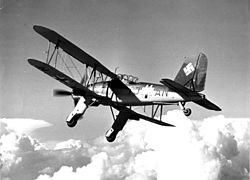Fieseler Fi 167
| Fieseler Fi 167 | |
|---|---|
 Fieseler Fi 167 A-0 in flight |
|
| Type: | Multi-purpose carrier aircraft |
| Design country: | |
| Manufacturer: |
Fieseler Flugzeugbau Kassel |
| First flight: |
November 12, 1937 |
| Production time: |
1936-1942 |
| Number of pieces: |
14-15 |
The Fieseler Fi 167 was a single-engine German biplane fighter aircraft. The construction of the Fieseler Flugzeugbau Kassel (from April 1939: Gerhard-Fieseler-Werke) was primarily intended for use as a torpedo bomber and reconnaissance aircraft .
The aircraft was developed for the tender for the multi-purpose carrier aircraft for the planned aircraft carrier Graf Zeppelin and carrier B (name not specified).
history
Development work began on November 15, 1936. The Fi 167 was made of all-metal construction. It had a disguised, detachable landing gear and swimming cells in the lower wing. The upper and lower wings of the biplane could be folded back onto the fuselage. The basic design provided for an aircraft that took into account all the high-lift aids of the Fi 156 . The end result was an aircraft that, during carrier landings, could have touched down practically vertically on the landing deck of the carrier in motion. Three prototypes were built, the D – OCML (V1), D – OFWP (V2) and D – OJBZ (V3). In addition, there were a further eleven to twelve A-0 pre-series machines by 1942, which were used until 1943. Series production did not take place due to the construction stop on the Graf Zeppelin in 1940. When aircraft carrier construction began again in 1942, the now clearly outdated Fi 167 (see Nakajima B5N or Grumman TBF ) was no longer intended as a carrier aircraft.
The remaining machines were used until 1943 in the Netherlands with the test squadron 167 as coastal pilots. Various tests were carried out, such as investigations into camouflage paints for sea pilots. In September 1944 the machines were handed over to Croatia and used there as supply aircraft and reconnaissance aircraft in the 1st squadron in Zagreb . After the war, some were taken over by the newly formed Yugoslav Air Force.
Technical specifications
| Parameter | Data |
|---|---|
| crew | 2 (pilot / observer) |
| span | 13.50 m folded 5.75 m |
| length | 11.43 m |
| height | 4.53 in the spur position 5.46 in the horizontal position |
| Wing area | 45.50 m² |
| Wing loading | 75-105 kg / m² |
| Power load | 3.1-4.4 kg / hp |
| Empty mass | 3030 kg |
| Payload | 1770 kg |
| Takeoff mass | normal 4050 kg maximum 4800 kg |
| Engine | a twelve-cylinder engine DB 601 B-1 |
| power | 809 kW (1,100 hp) |
| Top speed | 320 km / h near the ground |
| Cruising speed | 270 km / h at an altitude of 3500 m |
| Landing speed | 95 km / h |
| Rise time | 1.3 min at 1000 m |
| Summit height | 7500 m |
| Range | Max. 1300 km 650 km at maximum take-off mass |
| Armament | two 7.92 mm MG 17 , four 50 kg and one 250 kg or one 500 kg bombs maximum one SC-1000 or one Lt5b torpedo |
literature
- Rolf Nagel, Thorsten Bauer: Kassel and the aviation industry since 1923 . Bernecker, Melsungen 2015, ISBN 978-3-87064-147-4 .
Web links
Individual evidence
- ↑ Nagel, Bauer, page 260 (data sheet for Fi-Muster. Fi 167)
- ↑ Bruno Lange: Type manual of German aviation technology . In: German aviation . tape 9 . Bernard & Graefe, Koblenz 1986, ISBN 3-7637-5284-6 , pp. 136 .
- ^ Fi 167 , accessed June 6, 2010.